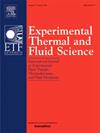考虑干扰气弹效应的高层建筑风荷载特性试验研究
IF 3.3
2区 工程技术
Q2 ENGINEERING, MECHANICAL
Experimental Thermal and Fluid Science
Pub Date : 2025-04-06
DOI:10.1016/j.expthermflusci.2025.111489
引用次数: 0
摘要
为了研究建筑物间相互干扰对作用于扰动结构的风荷载的影响,采用高宽比为6:1的两个相同方截面超高层建筑进行了研究。进行了考虑气动弹性效应的风洞压力试验。结果表明,当干扰建筑物斜置在上游或并置时,气动弹性效应的影响显著。上游建筑的存在降低了受扰动建筑的平均压力系数(CP,均值)。然而,当干扰建筑物位于正上游时,干扰效应导致受干扰建筑物大多数角点的压力系数(CP, rms)均方根增加。无论风角如何变化,除干扰建筑上游的部分位置外,受扰建筑的风压系数极值往往出现在建筑物迎风侧的转角附近。不同位置的干扰对平均气动力系数有不同的影响。具体而言,来自上游倾斜位置的干扰增加了受扰动建筑物的平均升力系数(CL, mean),而来自下游倾斜位置的干扰增加了平均阻力系数(CD, mean)。气动力系数的功率谱最明显地受到直接位于上游的建筑物的影响。此外,随着风向角的增大,功率谱的变化更加明显。本文章由计算机程序翻译,如有差异,请以英文原文为准。
Experimental study on the wind load characteristics of high-rise buildings considering the aeroelastic effect of interference
To examine the impact of mutual interference between buildings on the wind loads acting on disturbed structures, a study was conducted using two identical square-section ultrahigh-rise buildings with a height-to-width ratio of 6:1. The wind tunnel pressure test considering aeroelastic effect was carried out. The results indicate that the influence of the aeroelastic effect is significant when the interfering building is positioned obliquely upstream or in a juxtaposed configuration. Then, the presence of upstream buildings reduces the mean pressure coefficient (CP, mean) of the disturbed building. However, when the interfering building is positioned directly upstream, the interference effect leads to an increase in the root mean square of the pressure coefficient (CP, rms) at most corner points of the disturbed building. Regardless of how the wind angle changes, except for some locations upstream of the interfering building, the extreme value of the wind pressure coefficient of the disturbed building often appears near the corner of the windward side of the building. The interference from different positions has varying effects on the mean aerodynamic force coefficients. Specifically, interference from an upstream oblique position increases the mean lift coefficient (CL, mean) of the disturbed building, whereas interference from a downstream oblique position increases the mean drag coefficient (CD, mean). The power spectrum of the aerodynamic force coefficients is most notably influenced by a building positioned directly upstream. Furthermore, as the wind direction angle increases, the changes in the power spectrum become more pronounced.
求助全文
通过发布文献求助,成功后即可免费获取论文全文。
去求助
来源期刊

Experimental Thermal and Fluid Science
工程技术-工程:机械
CiteScore
6.70
自引率
3.10%
发文量
159
审稿时长
34 days
期刊介绍:
Experimental Thermal and Fluid Science provides a forum for research emphasizing experimental work that enhances fundamental understanding of heat transfer, thermodynamics, and fluid mechanics. In addition to the principal areas of research, the journal covers research results in related fields, including combined heat and mass transfer, flows with phase transition, micro- and nano-scale systems, multiphase flow, combustion, radiative transfer, porous media, cryogenics, turbulence, and novel experimental techniques.
 求助内容:
求助内容: 应助结果提醒方式:
应助结果提醒方式:


